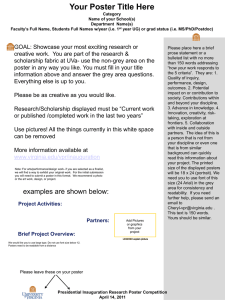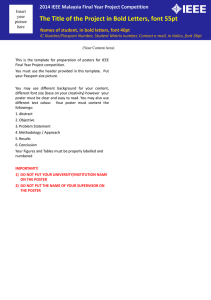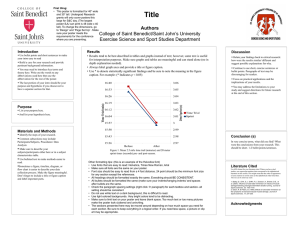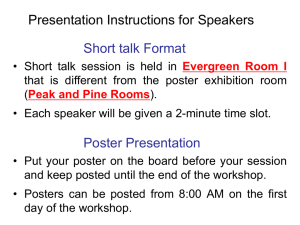Sample Poster - SUNY College of Environmental Science and Forestry
advertisement
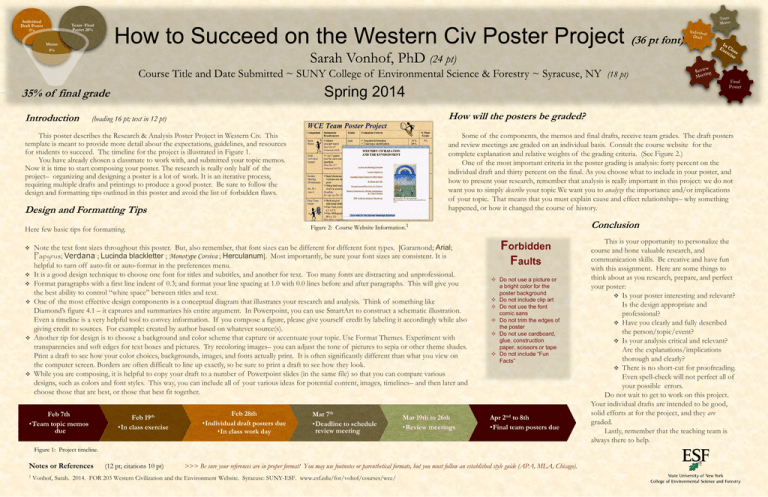
Individual Draft Poster 5% Team Final Poster 20% Memo 5% Spring 2014 35% of final grade Introduction How will the posters be graded? (heading 16 pt; text in 12 pt) Some of the components, the memos and final drafts, receive team grades. The draft posters and review meetings are graded on an individual basis. Consult the course website for the complete explanation and relative weights of the grading criteria. (See Figure 2.) One of the most important criteria in the poster grading is analysis: forty percent on the individual draft and thirty percent on the final. As you choose what to include in your poster, and how to present your research, remember that analysis is really important in this project: we do not want you to simply describe your topic We want you to analyze the importance and/or implications of your topic. That means that you must explain cause and effect relationships– why something happened, or how it changed the course of history. This poster describes the Research & Analysis Poster Project in Western Civ. This template is meant to provide more detail about the expectations, guidelines, and resources for students to succeed. The timeline for the project is illustrated in Figure 1. You have already chosen a classmate to work with, and submitted your topic memos. Now it is time to start composing your poster. The research is really only half of the project– organizing and designing a poster is a lot of work. It is an iterative process, requiring multiple drafts and printings to produce a good poster. Be sure to follow the design and formatting tips outlined in this poster and avoid the list of forbidden flaws. Design and Formatting Tips Note the text font sizes throughout this poster. But, also remember, that font sizes can be different for different font types. [Garamond; Arial; Papyrus; Verdana ; Lucinda blackletter ; Monotype Corsiva ; Herculanum]. Most importantly, be sure your font sizes are consistent. It is helpful to turn off auto-fit or auto-format in the preferences menu. It is a good design technique to choose one font for titles and subtitles, and another for text. Too many fonts are distracting and unprofessional. Format paragraphs with a first line indent of 0.3; and format your line spacing at 1.0 with 0.0 lines before and after paragraphs. This will give you the best ability to control “white space” between titles and text. One of the most effective design components is a conceptual diagram that illustrates your research and analysis. Think of something like Diamond’s figure 4.1 – it captures and summarizes his entire argument. In Powerpoint, you can use SmartArt to construct a schematic illustration. Even a timeline is a very helpful tool to convey information. If you compose a figure, please give yourself credit by labeling it accordingly while also giving credit to sources. For example: created by author based on whatever source(s). Another tip for design is to choose a background and color scheme that capture or accentuate your topic. Use Format Themes. Experiment with transparencies and soft edges for text boxes and pictures. Try recoloring images– you can adjust the tone of pictures to sepia or other theme shades. Print a draft to see how your color choices, backgrounds, images, and fonts actually print. It is often significantly different than what you view on the computer screen. Borders are often difficult to line up exactly, so be sure to print a draft to see how they look. While you are composing, it is helpful to copy your draft to a number of Powerpoint slides (in the same file) so that you can compare various designs, such as colors and font styles. This way, you can include all of your various ideas for potential content, images, timelines– and then later and choose those that are best, or those that best fit together. Feb 7th •Team topic memos due Feb 19th •In class exercise Conclusion Figure 2: Course Website Information.1 Here few basic tips for formatting. Final Poster Feb 28th •Individual draft posters due •In class work day Mar 7th •Deadline to schedule review meeting Mar 19th to 26th •Review meetings Forbidden Faults Do not use a picture or a bright color for the poster background Do not include clip art Do not use the font comic sans Do not trim the edges of the poster Do not use cardboard, glue, construction paper, scissors or tape Do not include “Fun Facts” Apr 2nd to 8th •Final team posters due Figure 1: Project timeline. Notes or References 1 (12 pt; citations 10 pt) >>> Be sure your references are in proper format! You may use footnotes or parenthetical formats, but you must follow an established style guide (APA, MLA, Chicago). Vonhof, Sarah. 2014. FOR 203 Western Civilization and the Environment Website. Syracuse: SUNY-ESF. www.esf.edu/for/vohof/courses/wce/ This is your opportunity to personalize the course and hone valuable research, and communication skills. Be creative and have fun with this assignment. Here are some things to think about as you research, prepare, and perfect your poster: Is your poster interesting and relevant? Is the design appropriate and professional? Have you clearly and fully described the person/topic/event? Is your analysis critical and relevant? Are the explanations/implications thorough and clearly? There is no short-cut for proofreading. Even spell-check will not perfect all of your possible errors. Do not wait to get to work on this project. Your individual drafts are intended to be good, solid efforts at for the project, and they are graded. Lastly, remember that the teaching team is always there to help. Final Poster Introduction How will the posters be graded? (heading 16 pt; text in 12 pt) This poster describes the Research & Analysis Poster Project in Western Civ. This template is meant to provide more detail about the expectations, guidelines, and resources for students to succeed. The timeline for the project is illustrated in Figure 1. You have already chosen a classmate to work with, and submitted your topic memos. Now it is time to start composing your poster. The research is really only half of the project– organizing and designing a poster is a lot of work. It is an iterative process, requiring multiple drafts and printings to produce a good poster. Be sure to follow the design and formatting tips outlined in this poster and avoid the list of forbidden flaws. Some of the components, the memos and final drafts, receive team grades. The draft posters and review meetings are graded on an individual basis. Consult the course website for the complete explanation and relative weights of the grading criteria. (See Figure 2.) One of the most important criteria in the poster grading is analysis: forty percent on the individual draft and thirty percent on the final. As you choose what to include in your poster, and how to present your research, remember that analysis is really important in this project: we do not want you to simply describe your topic We want you to analyze the importance and/or implications of your topic. That means that you must explain cause and effect relationships– why something happened, or how it changed the course of history. Design and Formatting Tips Figure 2: Course Website Information.1 Here few basic tips for formatting. Note the text font sizes throughout this poster. But, also remember, that font sizes can be different for different font types. [Garamond; Arial; Papyrus; Verdana ; Lucinda blackletter ; Monotype Corsiva ; Herculanum]. Most importantly, be sure your font sizes are consistent. It is helpful to turn off auto-fit or auto-format in the preferences menu. It is a good design technique to choose one font for titles and subtitles, and another for text. Too many fonts are distracting and unprofessional. Format paragraphs with a first line indent of 0.3; and format your line spacing at 1.0 with 0.0 lines before and after paragraphs. This will give you the best ability to control “white space” between titles and text. One of the most effective design components is a conceptual diagram that illustrates your research and analysis. Think of something like Diamond’s figure 4.1 – it captures and summarizes his entire argument. In Powerpoint, you can use SmartArt to construct a schematic illustration. Even a timeline is a very helpful tool to convey information. If you compose a figure, please give yourself credit by labeling it accordingly while also giving credit to sources. For example: created by author based on whatever source(s). Another tip for design is to choose a background and color scheme that capture or accentuate your topic. Use Format Themes. Experiment with transparencies and soft edges for text boxes and pictures. Try recoloring images– you can adjust the tone of pictures to sepia or other theme shades. Print a draft to see how your color choices, backgrounds, images, and fonts actually print. It is often significantly different than what you view on the computer screen. Borders are often difficult to line up exactly, so be sure to print a draft to see how they look. While you are composing, it is helpful to copy your draft to a number of Powerpoint slides (in the same file) so that you can compare various designs, such as colors and font styles. This way, you can include all of your various ideas for potential content, images, timelines– and then later and choose those that are best, or those that best fit together. Feb 7th •Team topic memos due Feb 19th •In class exercise Feb 28th •Individual draft posters due •In class work day Mar 7th •Deadline to schedule review meeting Mar 19th to 26th •Review meetings Forbidden Faults Do not use a picture or a bright color for the poster background Do not include clip art Do not use the font comic sans Do not trim the edges of the poster Do not use cardboard, glue, construction paper, scissors or tape Do not include “Fun Facts” Apr 2nd to 8th •Final team posters due Conclusion This is your opportunity to personalize the course and hone valuable research, and communication skills. Be creative and have fun with this assignment. Here are some things to think about as you research, prepare, and perfect your poster: Is your poster interesting and relevant? Is the design appropriate and professional? Have you clearly and fully described the person/topic/event? Is your analysis critical and relevant? Are the explanations/implications thorough and clearly? There is no short-cut for proofreading. Even spell-check will not perfect all of your possible errors. Do not wait to get to work on this project. Your individual drafts are intended to be good, solid efforts at for the project, and they are graded. Lastly, remember that the teaching team is always there to help. Figure 1: Project timeline. Notes or References 1 (12 pt; citations 10 pt) >>> Be sure your references are in proper format! You may use footnotes or parenthetical formats, but you must follow an established style guide (APA, MLA, Chicago). Vonhof, Sarah. 2014. FOR 203 Western Civilization and the Environment Website. Syracuse: SUNY-ESF. www.esf.edu/for/vohof/courses/wce/ Spring 2014 Final Poster INTRODUCTION HOW WILL THE POSTERS BE GRADED? (heading 16 pt; text in 12 pt) This poster describes the Research & Analysis Poster Project in Western Civ. This template is meant to provide more detail about the expectations, guidelines, and resources for students to succeed. The timeline for the project is illustrated in Figure 1. You have already chosen a classmate to work with, and submitted your topic memos. Now it is time to start composing your poster. The research is really only half of the project– organizing and designing a poster is a lot of work. It is an iterative process, requiring multiple drafts and printings to produce a good poster. Be sure to follow the design and formatting tips outlined in this poster and avoid the list of forbidden flaws. Figure 2: Course Website Information.1 Figure 1: Project timeline. Feb 7th •Team topic memos due Feb 28th •Individual draft posters due •In class work day Feb 19th •In class exercise Mar 7th •Deadline to schedule review meeting Some of the components, the memos and final drafts, receive team grades. The draft posters and review meetings are graded on an individual basis. Consult the course website for the complete explanation and relative weights of the grading criteria. (See Figure 2.) One of the most important criteria in the poster grading is analysis: forty percent on the individual draft and thirty percent on the final. As you choose what to include in your poster, and how to present your research, remember that analysis is really important in this project: we do not want you to simply describe your topic We want you to analyze the importance and/or implications of your topic. That means that you must explain cause and effect relationships– why something happened, or how it changed the course of history. CONCLUSION Mar 19th to 26th •Review meetings Apr 2nd to 8th •Final team posters due DESIGN AND FORMATTING TIPS Note the text font sizes throughout this poster. But, also remember, that font sizes can be different for different font types. [Garamond; Arial; Papyrus; Verdana ; Lucinda blackletter ; Monotype Corsiva ; Herculanum]. Most importantly, be sure your font sizes are consistent. It is helpful to turn off auto-fit or auto-format in the preferences menu. It is a good design technique to choose one font for titles and subtitles, and another for text. Too many fonts are distracting and unprofessional. Format paragraphs with a first line indent of 0.3; and format your line spacing at 1.0 with 0.0 lines before and after paragraphs. This will give you the best ability to control “white space” between titles and text. One of the most effective design components is a conceptual diagram that illustrates your research and analysis. Think of something like Diamond’s figure 4.1 – it captures and summarizes his entire argument. In Powerpoint, you can use SmartArt to construct a schematic illustration. Even a timeline is a very helpful tool to convey information. If you compose a figure, please give yourself credit by labeling it accordingly while also giving credit to sources. For example: created by author based on whatever source(s). Another tip for design is to choose a background and color scheme that capture or accentuate your topic. Use Format Themes. Experiment with transparencies and soft edges for text boxes and pictures. Try recoloring images– you can adjust the tone of pictures to sepia or other theme shades. Print a draft to see how your color choices, backgrounds, images, and fonts actually print. It is often significantly different than what you view on the computer screen. Borders are often difficult to line up exactly, so be sure to print a draft to see how they look. While you are composing, it is helpful to copy your draft to a number of Powerpoint slides (in the same file) so that you can compare various designs, such as colors and font styles. This way, you can include all of your various ideas for potential content, images, timelines– and then later and choose those that are best, or those that best fit together. Notes or References 1 (12 pt; citations 10 pt) Forbidden Faults Do not use a picture or a bright color for the poster background Do not include clip art Do not use the font comic sans Do not trim the edges of the poster Do not use cardboard, glue, construction paper, ors or tape Do not include “Fun Facts” >>> Be sure your references are in proper format! You may use footnotes or parenthetical formats, but you must follow an established style guide (APA, MLA, Chicago). Vonhof, Sarah. 2014. FOR 203 Western Civilization and the Environment Website. Syracuse: SUNY-ESF. www.esf.edu/for/vohof/courses/wce/ This is your opportunity to personalize the course and hone valuable research, and communication skills. Be creative and have fun with this assignment. Here are some things to think about as you research, prepare, and perfect your poster: Is your poster interesting and relevant? Is the design appropriate and professional? Have you clearly and fully described the person/topic/event? Is your analysis critical and relevant? Are the explanations/implications thorough and clearly? There is no short-cut for proofreading. Even spell-check will not perfect all of your possible errors. Do not wait to get to work on this project. Your individual drafts are intended to be good, solid efforts at for the project, and they are graded. Lastly, remember that the teaching team is always there to help.

